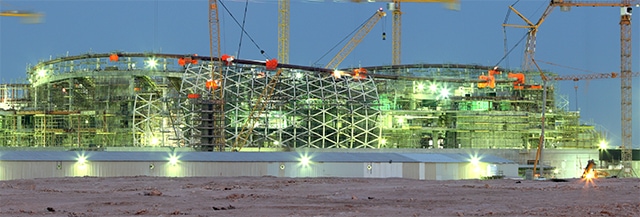Extensive infrastructure plans require imported labor, always a tricky issue.

Over the next five years, Qatar plans to spend more than $200 billion on infrastructure projects, including roads, bridges, railways, ports and the Doha metro.
The labor for these projects will be imported under a new law (effective December 13, 2016) that abolishes the kafala sponsorship system and allows foreign workers to apply for exit permits themselves, without their employer’s permission.
The construction sector is the largest employer in Qatar, and it is growing faster than in any other Gulf nation, ahead of the FIFA World Cup, spurred by the Qatar National Vision 2030 roadmap for the country’s future. The industry has been roundly criticized by rights organizations for its poor treatment of migrant workers. Facing the threat of a possible United Nations probe, Qatar has improved worker accommodations and given the workers new legal protections.
In March, the UN’s International Labour Organization sent a delegation to Qatar, where it found employees stranded without pay or passports. The new law abolishes the two-year ban on expatriates who want to come back to the country on a new visa. A person who has previously worked in Qatar no longer must get the approval of the prior sponsor if recruited by another company. There is also now a $6,865 fine for keeping the passport of an expat employee.
Meanwhile, the committee responsible for building the World Cup sites said in October that a worker on a new stadium died in the first work-related fatality for the tournament preparations. It said a full investigation was under way. Qatar previously reported three deaths at stadium construction sites that were not work-related.
|
Central Bank: Qatar Central Bank | |||
|
International Reserves |
$36,923.4 billion | ||
|
Gross Domestic Product (GDP) |
$185.4 billion* | ||
|
Real GDP Growth |
2013 13.0% |
2014 6.1% |
2015* 6.5% |
|
GDP Per Capita—Current Prices |
$76,576* | ||
|
GDP—Composition By Sector* |
agriculture: 0.1% |
industry: 55.7% |
services: 44.1% |
|
Inflation |
2013 3.1% |
2014 3.3% |
2015* 1.7% |
|
Public Debt (general government |
2013 32.6% |
2014* 32.6% |
2015* 35.8% |
|
Government Bond Ratings (foreign currency) |
Standard & Poor’s AA |
Moody’s Aa2 |
Moody’s Outlook NEG |
|
FDI Inflows |
2013 $840 million |
2014 $1,040.4 million |
2015 $1,070.9 million |



